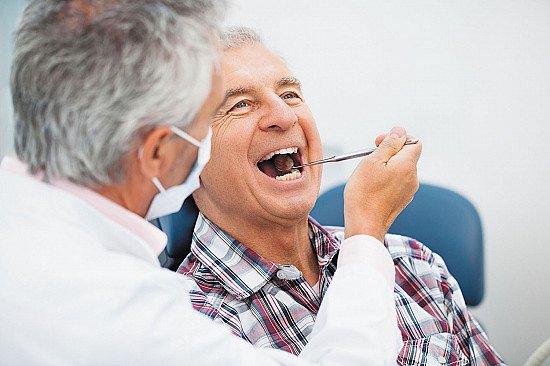[ad_1]

The eyes may be the gateway to your soul, but oral health is a window to overall health. “Good dental health not only protects against gum disease, gum inflammation and tooth loss, but can also protect against many other age-related diseases,” says Dr. Len Brennan of Harvard School of Dental Medicine. “A healthy mouth can actually lead to a healthier body.”
A healthy smile
Poor oral health can have serious consequences. Research has shown that inflammation of the gums (gingivitis) increases the risk of lung disease, heart disease, blocked blood vessels and stroke.
Tooth loss due to gum disease (periodontitis) can increase your risk of dementia. In the October 2021 issue of JAMDA: The Journal of Post-Acute and Long-Term Care MedicineResearchers looked at 14 studies and found that older adults who lost more than one tooth had a nearly 50% higher risk of developing cognitive impairment and a 28% higher risk of being diagnosed with dementia.
Poor dental health can also affect your social life. “Insecurities about your smile can make you feel less attractive and less likely to socialize, which can increase isolation,” says Dr. Brennan.
Making Sense of Sensitive Teeth and Dry MouthTwo common dental problems that many older adults face are sensitive teeth and dry mouth. Tooth sensitivity often occurs when you eat or drink hot or cold foods. A typical cause is shrinking gums, which further exposes the root of a tooth. Grinding your teeth while you sleep can also cause sensitivity, so you may need to use a mouthguard at night. A dry mouth means you produce less saliva, making it difficult to taste, chew, swallow, and even speak. Dry mouth is also a common side effect of many medications and is linked to health problems such as diabetes, stroke, Alzheimer’s disease, and autoimmune diseases. Since sensitive teeth and dry mouth have many different causes, consult your dentist to find the source of your problem. |
Rinse, brush, floss
As with other aspects of health care, prevention is the best medicine when it comes to your teeth and gums. “Investing in proper dental care and maintenance is relatively inexpensive,” says Dr. Brennan. “Dental treatments can be expensive.”
He recommends seeing your dentist every six months for exams, x-rays if necessary, and cleanings. In between, you need to follow a daily dental hygiene routine to reduce plaque buildup, gingivitis, and cavities. There are three basic steps: rinsing, brushing and flossing.
Rinsing. Before brushing, rinse with clean water to dislodge food particles. After brushing, you can rinse again with an over-the-counter alcohol- and fluoride-free mouthwash, which can help protect against tooth decay. Certain products can reduce tooth sensitivity. Ask your pharmacist for a suggestion. If you have trouble controlling plaque, gingivitis, bad breath or dry mouth, talk to your dentist about a therapeutic mouthwash.
Brushing. Brush at least twice a day for at least two minutes each time. Choose a toothpaste with the American Dental Association (ADA) Seal of Acceptance, which verifies that it contains fluoride that fights cavities and plaque. Toothpastes come in gel, paste or powder form. Although the ingredients may differ slightly, all toothpastes contain the same general components: mild abrasives, humectants, flavoring agents, thickening agents, and detergents.
Some brands also contain other ingredients that may reduce tooth sensitivity or tartar buildup, prevent enamel erosion, or whiten teeth. Ask your dentist for a recommendation for these specific issues.
“Natural” toothpastes are also popular, but again look for the ADA seal. Natural means that certain ingredients are omitted, such as artificial flavors, colors, preservatives and sweeteners. This also means that some active ingredients that help with cleaning are derived from plant sources.
Select a brush with soft or extra-soft bristles. Replace toothbrushes every three to four months, or more often if the bristles are visibly tangled or frayed.
When brushing, tilt the brush at a 45° angle. Starting with the upper teeth, make several short, up-and-down movements from the gum to the bottom of the tooth. Do one tooth at a time before moving on to the next one. To clean the inside surfaces of the front teeth, hold the brush vertically and use several up and down strokes. Repeat the process for the lower teeth.
If you have arthritis that makes it difficult to brush or hold a toothbrush, or if it’s difficult to reach your back teeth, invest in gripping aids that slide over the handle of your brush . Another option is an electric toothbrush. You can get more strokes from the vibrations of the brush than from the movement of your hand. Some brands come with timers that tell you when you’ve brushed long enough.
Dental floss. It doesn’t matter if you floss before or after brushing, according to Dr. Brennan. “But also try to floss more than once a day, if possible, preferably after a meal, to reduce the buildup of bacteria in the mouth.”
You can use waxed or unwaxed thread. People with particularly tight teeth may find waxed floss easier to use, but both types work the same.
Wrap the floss around your middle finger, which helps you reach the back teeth. Wrap the floss around each tooth to make a C shape. Starting at the gum, slide it up and down the tooth several times. Avoid simply moving the wire back and forth in a sawing motion. Not only do you miss cleaning the entire tooth, but the friction can irritate the gums.
“If bleeding gums occur, it doesn’t mean you should stop flossing,” says Dr. Brennan. “Instead, just be gentler in that area.”
If using traditional floss is difficult, you can try over-the-counter tools, such as toothpicks, toothpicks, pre-threaded floss, small brushes that extend between teeth (which are particularly useful for getting under crowns and bridges), and water flossers.
Image: © alvarez/Getty Images
[ad_2]
Source link
